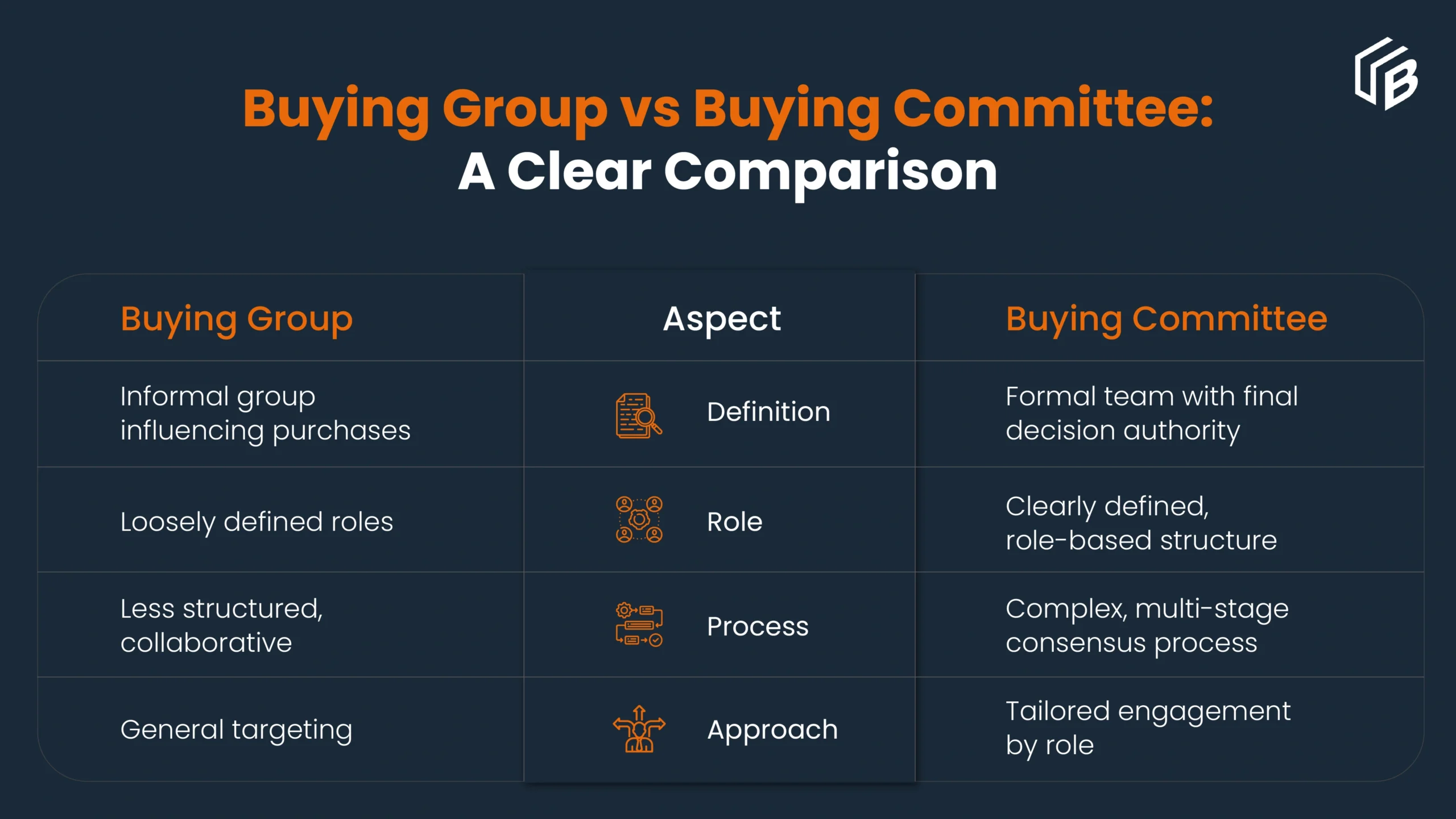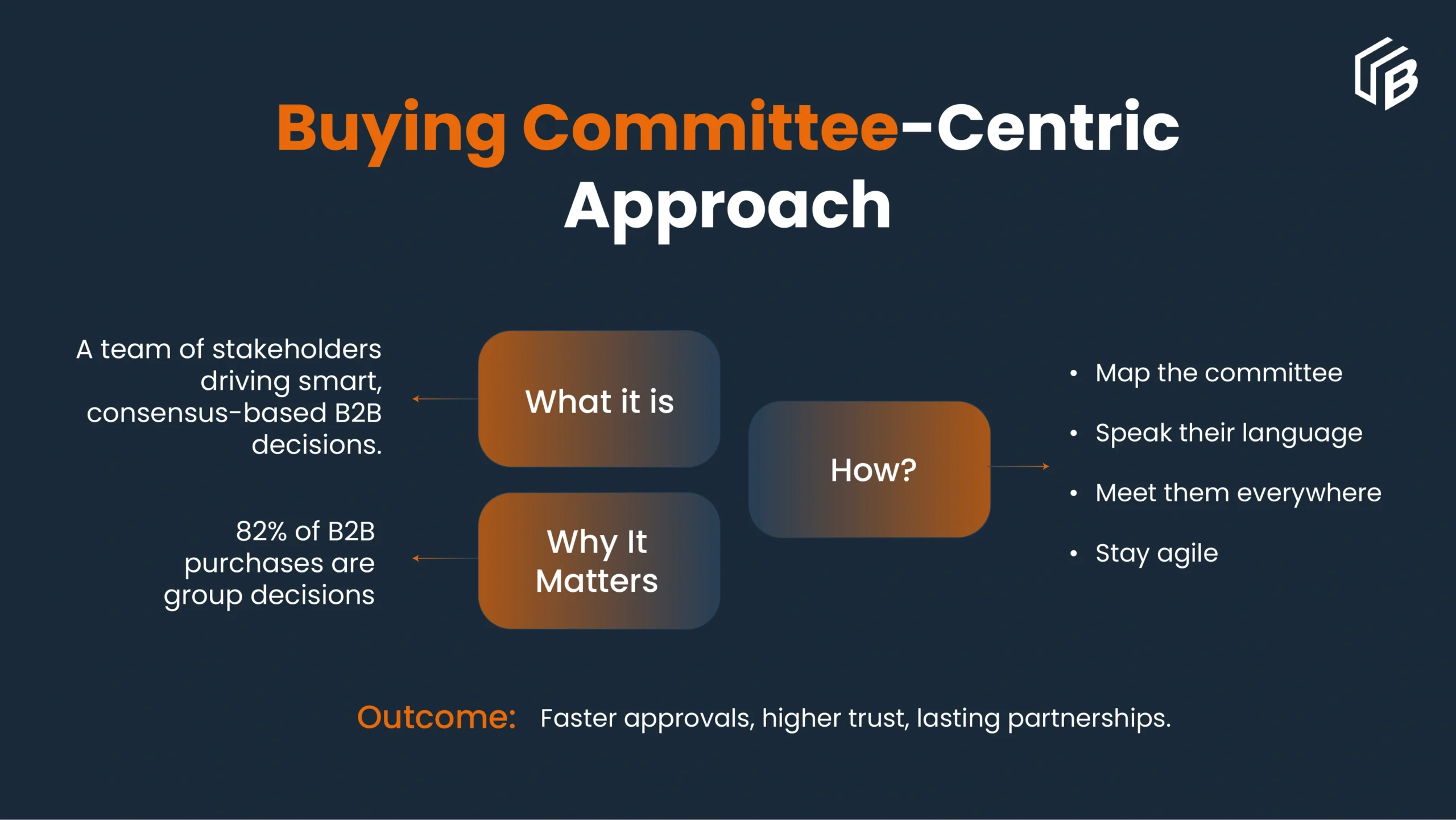
Highlights
- B2B buying committees average 10–11 members, with 52% including VP-level executives.
- Marketers must identify roles and tailor content to address each stakeholder’s priorities.
- Multi-channel engagement like webinars, white papers, and emails is critical for committee influence.
- Consensus-driven buying committees now dictate 82% of B2B purchase decisions.
The buying committee has become the heart of modern B2B purchases, bringing together diverse stakeholders from multiple departments, each influencing critical decisions. Gone are the days of a single decision-maker. Today, these committees often include 10 or more members, making the buying journey far more complex.
For marketers, this means understanding the unique roles within these committees is essential to engage effectively and drive consensus. Success depends on identifying every member, creating personalized content that addresses their specific concerns, and using real-time data to anticipate their needs.
The ability to master these dynamics defines who wins in today’s B2B market.
Who is Actually Part of the Buying Committee?
In 2025, the average B2B buying committee is a team of 10–11 stakeholders, and for big enterprise deals, it can even stretch to 15 people. These committees pull in members from everywhere, IT, finance, procurement, operations, and yes, even the C-suite.
Each member plays a specific role:
- Initiators: Identify the need and begin the process
- End Users: Individuals who will ultimately use the solution
- Influencers: Shape opinions and recommend options
- Decision-Makers: Have final authority over the purchase
- Gatekeepers: Control access to key decision-makers
- Procurement Officers: Manage purchasing and compliance
- Executive Sponsors: Senior leaders who advocate for the solution and ensure alignment with strategic objectives
- Financial Approvers: Validate budget allocation and ROI before sign-off
- Risk Managers: Evaluate potential risks and can halt the process if concerns are not addressed
Senior leadership involvement is significant, as 52% of buying committees include VP-level or higher executives, and CFOs participate in 79% of purchase decisions, making financial validation a critical step.
Bottom line? Mapping out who’s who and understanding their role is your starting point for building a winning buying committee strategy.
What is a B2B Buying Committee?
A B2B buying committee is a multidisciplinary group within an organization responsible for vetting and approving major purchases. Unlike individual decision-making, a buying committee operates with a strategic focus on long-term scalability, compliance, and risk mitigation. As the B2B buying process has evolved, these committees have become central to ensuring that investments align with business objectives, technical requirements, and financial constraints. Understanding the buying committee roles, from decision-makers and influencers to financial approvers, is crucial for marketers and sales teams aiming to build trust and deliver relevant value throughout the process.
What Distinguishes a Buying Committee from a Buying Group?
While the terms are often used interchangeably, there’s a clear distinction between a buying group and a buying committee. A buying group may informally discuss potential solutions, but a buying committee is a formal, empowered team tasked with evaluating vendors, managing cross-departmental impact, and driving consensus across stakeholders. For marketers, this means adopting buying committee best practices in 2025, such as using a buying committee checklist for marketers, creating role-based content, and deploying a strong buying committee engagement strategy. As the evolution of the B2B buying committee continues, success depends on how well you map out committee roles, anticipate objections, and influence decision-making at every stage of the buying committee strategy.

When and How Do Marketers Engage the Buying Committee?
Recent data shows that most B2B buyers are already 69% through their purchase journey before they even engage sales teams, with 81% initiating contact only when ready to discuss specifics. The B2B buying process can last anywhere from 11 to 16 months, making sustained and strategic engagement critical for success.
To effectively engage a B2B buying committee, marketers must first identify all committee members early in the process. Leveraging tools such as CRM systems, intent data, and digital behavior analysis can provide a clear view of the committee structure and the roles on a B2B buying committee. From there, marketers should customize content to address the specific needs, priorities, and pain points of each stakeholder. Personalized communication in this way ensures meaningful engagement and supports a well-informed, consensus-driven decision-making process.
Where Does Engagement with the Buying Committee Occur?
Engaging a buying committee today happens across multiple digital channels, reflecting how busy stakeholders are researching and evaluating solutions. Studies show that 75% of committee members use social media and 97% visit vendor websites before ever speaking with a salesperson. This makes a multi-channel, full-funnel approach essential in the B2B buying process.
Marketers can capture attention and guide decisions by using webinars, white papers, personalized emails, and interactive tools, all tailored to the specific roles on a B2B buying committee. Keeping up continuous engagement across these touchpoints helps maintain momentum, even when committee deliberations are complex. Following the buying committee’s best practices for 2025 ensures that every interaction adds value, builds trust, and keeps the purchase process moving forward smoothly.
Why Is a Buying Committee-Centric Approach Critical for Marketers?
The buying committee represents the collective focus on reducing risk and ensuring long-term value in B2B purchases. Demandbase highlights that 82% of buying decisions are now made by groups rather than individuals, reflecting the growing importance of consensus among diverse stakeholders. Ignoring this reality puts deals at risk, as multiple perspectives and approvals are now standard. Marketers who understand and engage the full buying committee can accelerate sales cycles, improve win rates, and build stronger, trust-based relationships that last.

How Can Marketers Succeed with Buying Committees?
To succeed with a buying committee in the current B2B buying process, marketers need to understand the evolution of the B2B buying committee and the distinct roles on a B2B buying committee. Unlike an informal buying group, a B2B buying committee is a formal, empowered team responsible for evaluating solutions across departments and reaching consensus. Marketers who build a clear buying committee strategy and maintain consistent buying committee engagement are far more likely to earn trust, address concerns, and move decisions forward.
Practical steps for marketers:
- Identify all Members and Their Roles
- Tailor Content for Each Role
- Engage Across Multiple Channels
- Use a Buying Committee Checklist for Marketers
- Continuously Monitor Engagement
Track feedback and interactions to refine your buying committee strategy and maintain momentum throughout the B2B buying process.
FAQs
1. How Does a Buying Committee Impact the B2B Sales Cycle?
Buying committees extend the sales cycle as multiple stakeholders must align, but they also ensure more informed, consensus-driven decisions.
2. What Challenges Do Marketers Face With Buying Committees?
Marketers struggle to identify all members, understand diverse priorities, and deliver personalized engagement across multiple channels.
3. How Do Buying Committees Impact B2B Marketing Success?
Success depends on engaging every committee member effectively—role-aware strategies accelerate decisions, build trust, and improve conversion rates.
4. How To Map the B2B Buying Committee?
Identify all stakeholders, their roles, and influence levels using CRM data, research, and intent signals to guide targeted engagement.
Conclusion
The evolution of the B2B buying committee has transformed how marketers approach the B2B buying process. Marketing success now depends on understanding buying committee roles, coordinating efforts across stakeholders, and delivering content that speaks to each member’s priorities. Using real-time data helps anticipate needs, address concerns, and keep the decision-making process moving efficiently.
The buying committee has become the core unit of influence in today’s B2B environment. A thoughtful buying committee strategy strengthens buying committee engagement, builds credibility, and fosters the trust needed for long-term partnerships. Organizations that follow buying committee best practices in 2025 will not only improve conversions but also position themselves for sustainable growth in a complex, multi-stakeholder landscape.
Our blog
Latest blog posts
Tool and strategies modern teams need to help their companies grow.

Learn how to improve lead quality and boost conversion rates in B2B with AI enrichmen...

Unlock the Top 5 templates to boost your go-to-market strategy in 2025–2026 with AI...

Explore the differences between direct and programmatic ads, their trade-offs, when t...






